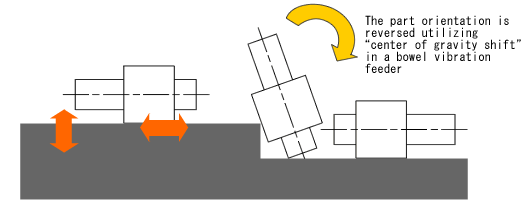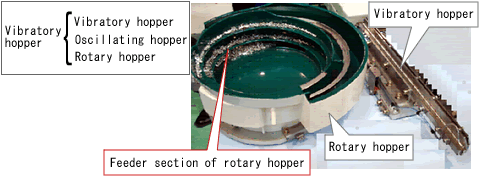HOME > Low Cost Automation Tutorial > #149 Production Technology Improvement Course for Mechanical Designers - 19: Component Alignment Technology: Direction Change
Low Cost Automation Tutorial
#149 Production Technology Improvement Course for Mechanical Designers - 19: Component Alignment Technology: Direction Change
Category : Automation elements technology
February22, 2013
Surface mount components such as capacitors and insertion parts for assembly need to be top/bottom and for/aft orientation aligned. The orientation alignment will be based on the unique characteristics of the subject components (shape differences, identification markings, and etc.).
Explanation on For/Aft orientation alignment
(1) When there are differences in front end and rear end shapes
The directional alignment is often performed utilizing the for/aft shape differences of the parts.
a) Movement of a part not requiring directional changes

b) Movement of a part requiring directional changes

(2) Parts feeding and aligning
| - | Small parts such as shown in the above example are randomly put in a funnel shaped vessel called "Hopper". |
| - | This Hopper is vibrated finely to perform parts orientation change operation on the "Alignment feeder". |
| - | There are following three vibratory methods for the Hopper. The vibratory hopper is also called Parts Feeder. |
| - | A vibrator unit is mounted below the hopper to make up the parts feeder. |
| - | The round hopper is sometimes called a Bowl. |
- Positioning technology
- Designing and processing
- Sensor Technology
- Automation elements technology
- Clean room technology
- Design hints
- Design tips
- Designing and Machining
- Drive mechanism design
- Hints on designing
- Linear Motion Components
- Locating Technology
- Manufacturing technology
- Motion mechanism design
- Pneumatic Drives
- Production Technology
- Technology Outlook
- General description
- Low-cost automation and materials
- Transfer LCA
- #333 Know-how on automation: Pressurized heating technology - 5: Multilayer pressurized heating process technique
- #332 Know-how on automation: Pressurized heating technology - 4: Points to remember when designing mechanism of pneumatic pressurization method
- #331 Know-how on automation: Pressurized heating technology - 3: Pneumatic pressurization method and pressure profile
- #330 Know-how on automation: Pressurized heating technology - 2: Pressurization method and pressure profile
- #329 Know-how on automation: Pressurized heating technology



